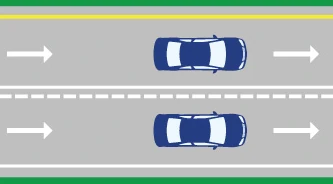 I've always wondered about the driver in the far left lane as I used the acceleration lane to join traffic already on the freeway. Would they change lanes to the right while I was trying to merge with the flow of fast moving traffic by moving into the same lane from the left?
I've always wondered about the driver in the far left lane as I used the acceleration lane to join traffic already on the freeway. Would they change lanes to the right while I was trying to merge with the flow of fast moving traffic by moving into the same lane from the left?
Not everyone bothers to signal their lane changes and having to move out of the lane before it ends adds to the complexity of my task as I join through traffic.

The Left Lane Cannot Move Right
A solution that I like is in use in the province of Quebec. The leftmost lane on the autoroute is marked with a combination broken and solid white line for the length of the on ramp. The solid line on the left side of the broken line tells drivers in the fast lane not to move to the right.
The Right Lane Can Move Left
It does allow drivers in the slow lane to move over to the left and make room for the merging driver if they wish to do so.
It Makes the Merge Safer
The system works when drivers follow the rules, removing one complication from the equation of joining the traffic flow for the merging driver.
Lines Don't Stop Some Drivers
Of course, a defensive driver would consider the possibility of another driver not obeying the solid line and scan for them anyway.
A Small Expense, Easily Implemented
This would not be a significant expense in comparison to other highway improvements aimed at reducing conflict and collisions. It would also be simple to implement in the course of repainting the lines each year.
What You Should Do Now
If this measure is not adopted, a responsible driver will still choose not to change lanes toward the acceleration lane and allow the merge to occur in safety.
Learn More
- Driving on Laned Roadway - Section 151 Motor Vehicle Act
- Manual of Standard Traffic Signs and Pavement Markings - British Columbia
Share This Article
I believe this system is also in use on the Edmonton - Calgary corridor in Alberta. I too have been a long time believer in entrenching this best practice in the MVA.
- Log in to post comments
Unfortunately this line type is not available to road designers in BC.
The Motor Vehicle Act defines any double line as a centerline. Many will be familiar with the fact that the act never mentions yellow with respect to centerlines, instead relying on line types.
155 (1) Despite anything in this Part, if a highway is marked with
(a) a solid double line, the driver of a vehicle must drive it to the right of the line only,
(b) a double line consisting of a broken line and a solid line,
(i) the driver of a vehicle proceeding along the highway on the side of the broken line must drive the vehicle to the right of the double line, except when passing an overtaken vehicle, and
(ii) the driver of a vehicle proceeding along the highway on the side of the solid line must drive the vehicle to the right of the double line, except only when finishing the passing of an overtaken vehicle [...]
Of course, this hasn't stopped it from showing up in a few spots. There are at least 2 locations in the province where this anti-weave strategy snuck through.
- Log in to post comments
I noticed that here in Kelowna they recently painted two lines between the bike lane and the vehicle lane. It might help to prevent drivers from crossing over into the bike lane, something that is very common here in Kelowna, however they may want to update the MVA, as attempting to stay to the right of them would involve driving in the bike lane.
- Log in to post comments
- Log in to post comments

Solid / Broken White Line in Combination